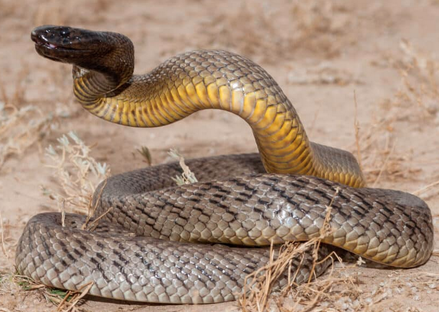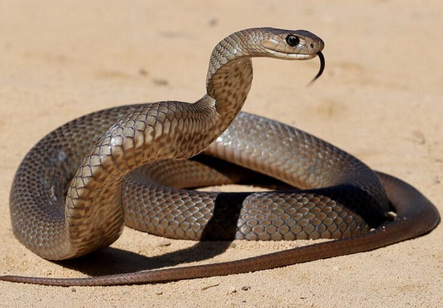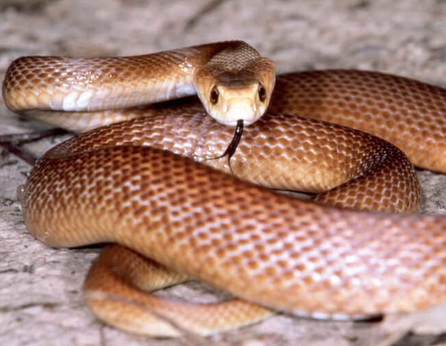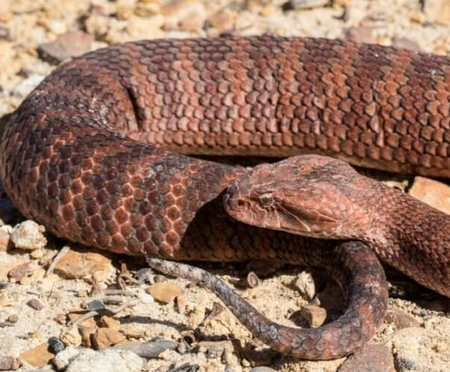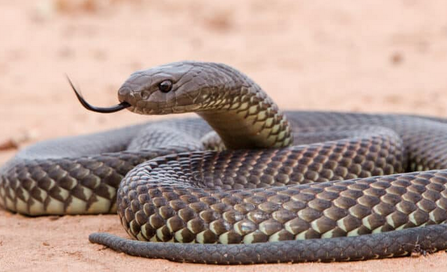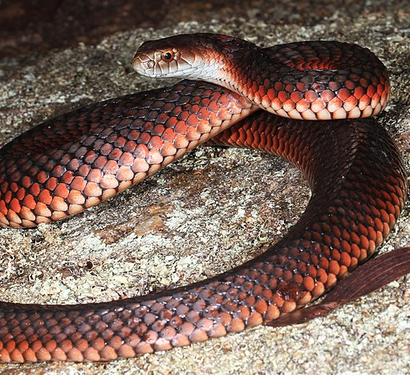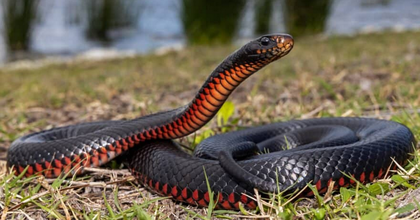Venomous Snakes in Australia
It is estimated that Australia hosts 66 venomous species, ranking beneath countries such as Brazil (with 79 species) and Mexico (with 80). The reason why almost all Australian snakes are venomous is that almost all of them are elapids— a venomous group characterized by its short fangs and agile nature. Some elapid species are small and shy around humans, while others are large and obtrusive. Striking with a downward stabbing motion, elapids kill by injecting a neurotoxic venom that causes immediate paralysis in prey.
|
Inland Taipan
The inland taipan (also commonly known as the western taipan) is the most venomous of any snake in Australia, and even in the world. This extremely venomous snake species is endemic to semi-arid regions of central east Australia. Aboriginal Australians living in those regions named the snake dandarabilla. It has a dark tan appearance and is an extremely fast and agile snake, attacking with extreme accuracy when provoked. Its highly toxic venom is said to be the most potent of any terrestrial snake in the world. One bite from the inland taipan has enough venom to kill at least 100 fully grown humans! |
|
Eastern Brown Snake
Found along the east coast of Australia, the eastern brown snake has a slender body build and can grow up to 7 feet in length. You’ll easily identify this snake by its pale brown with a pale cream-yellow underside often with orange or grey splotches. But don’t be deceived by its cool appearance – this is the world’s second-most venomous land snake and one of the deadliest snakes in the world! It is responsible for about 60% of human snake-bite deaths in Australia. The eastern brown snake is so venomous that the WHO also classified it as a snake of medical importance. |
|
Coastal Taipan
The coastal taipan grows over six feet in length. It is the third most venomous terrestrial snake in Australia and is very aggressive. Oxyuranus scutellatus scutellatus ranges in an arc along the east coast from northeastern New South Wales through Queensland, and across the northern parts of the Northern Territory to northern Western Australia. It has a deep, rectangular-shaped head distinct from the slender neck. Body colour may be yellowish, reddish brown, dark brown or almost black. The species undergoes a seasonal change in color, becoming darker in winter and fading in summer. The head is noticeably paler than the body. Eyes are large, with an intense orange-brown iris and round pupil. |
|
Common Death Adder
With a name that can send shivers down anyone’s spine, the common death adder is one of the most venomous land snakes in Australia and the world. The ‘death’ in this snake’s name is not a bluff – the common death adder can deliver the fastest strike among all venomous snakes recorded in Australia. It is capable of causing human death within six hours after a bite. Its body is broad and short with a thin tail that gives it the appearance of a viper , it has the longest fangs of any Australian snake! These snakes have a broad flattened, triangular head and a thick body with bands of red, brown and black with a grey, cream or pink belly. Common Death Adders are found in Northern Territory, Queensland, New South Wales, Victoria, South Australia and Western Australia. |
|
Mulga Snake
Alternatively known as king brown snake, the Mulga is another species of venomous snake native to western, northern, and central Australia. The mulga snake is responsible for 4% of recorded identified snake bite attacks in Australia. Even though its venom is not as potent as those of Australia’s other venomous snakes, when delivered in large quantities, the mulga snake’s venom has major effects – causing muscle paralysis and extensive pain and swelling. The species may be active both during the day and night (according to temperature). |
|
Lowland Copperhead
The lowlands copperhead (Austrelaps superbus) is found in southeastern Australia, including the coldest regions where most other snakes wouldn’t survive. They are also found in Tasmania. This elapid prefers to live in low vegetation areas near water bodies where they can prey on frogs, lizards, and other snakes. It is commonly referred to as the copperhead, but is not closely related to the American copperhead, Agkistrodon contortrix. This dangerous snake's neurotoxic and hemotoxic venom can kill an adult human with one bite if no medical assistance is provided immediately. Their colour varies a great deal, from a coppery mid-brown to yellowish, reddish, grey or black. The copper head coloring that gave rise to the common name is not always present. |
|
Red-Bellied Snake
One of the snakes most commonly encountered on the east coast of Australia, the red-bellied snake, is responsible for 16% of recorded identifiable snakebite victims in Australia. The name refers to its glossy black top body, bright red or orange flanks, and duller red belly. Although highly venomous, it is less venomous than other Australian elapid snakes. The red-bellied black snake is known to be non-aggressive and generally retreats from human encounters. |
